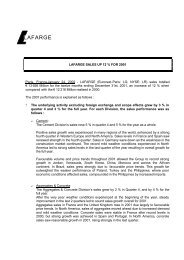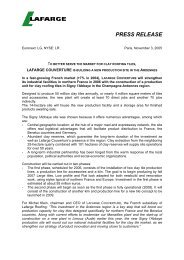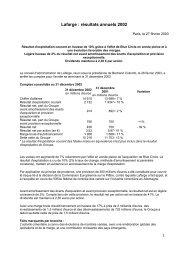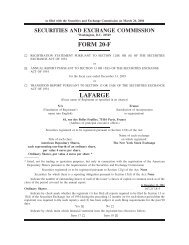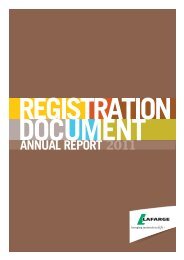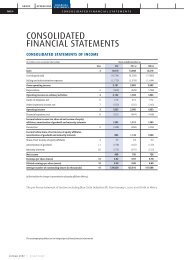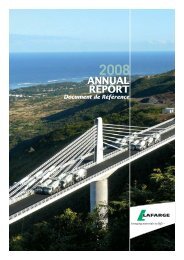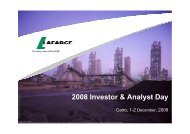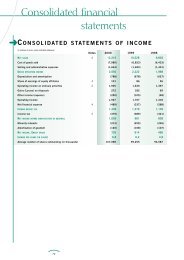2005 Sustainability Report - Lafarge
2005 Sustainability Report - Lafarge
2005 Sustainability Report - Lafarge
You also want an ePaper? Increase the reach of your titles
YUMPU automatically turns print PDFs into web optimized ePapers that Google loves.
Supporting the development of our employees<br />
FOSTERING DIVERSITY<br />
AND FIGHTING<br />
DISCRIMINATION<br />
Because our operations are anchored<br />
in local communities, our workforce<br />
shows a high level of diversity. Our aim<br />
is to maintain this diversity at every<br />
tier of the Group and to ensure that<br />
each individual is a candidate for<br />
internal promotion. This aim coincides<br />
with the management of employees'<br />
competencies. The Group is careful not<br />
to overlook the professional<br />
development of workers with a low<br />
level of qualification.<br />
AN AMBITIOUS PROGRAM<br />
TO GIVE WOMEN<br />
A STRONGER POSITION<br />
The proportion of women within the<br />
Group is increasing slowly. To reach<br />
our objective of doubling the number<br />
of women in senior management<br />
DIVERSITY WITHIN THE GROUP IN SOUTH AFRICA<br />
Frédéric de Rougemont,<br />
Chief Executive Officer of our Cement Business in South Africa.<br />
PAGE 28 | <strong>2005</strong> SUSTAINABILITY REPORT | LAFARGE<br />
positions between 2003 and 2008, the<br />
Group has implemented an ambitious<br />
program that is implemented in every<br />
Business Unit and incorporated in the<br />
annual “Organization and Human<br />
Resources” reviews. In addition, a<br />
dedicated compensation system for all<br />
the Group's managers (Hay system)<br />
helps to reduce the risks of discrepancy<br />
between the men's and women's<br />
salaries. A recent study carried out at<br />
units in France showed almost no<br />
difference between salaries paid to men<br />
and women performing jobs of the<br />
same level.<br />
PROMOTING EMPLOYMENT<br />
OF DISABLED PEOPLE<br />
In France and progressively throughout<br />
the world, <strong>Lafarge</strong> is pursuing an active<br />
policy to promote the integration of<br />
disabled people within the workforce<br />
through various means:<br />
“Since 1994, the legal framework in South Africa has aimed to achieve an economic balance between<br />
the white population and Previously Disadvantaged Individuals (PDI): blacks, mixed-race individuals<br />
and Indians. This law requires each company to set itself targets for the number of employees<br />
by sex and by ethnic category.<br />
We are working to meet these targets in different ways: accelerating the professional development of<br />
potential managers among the PDIs, positive discrimination at the recruitment stage, etc. In addition,<br />
intercultural training has helped to alter behavior, especially a recruitment manager's natural tendency<br />
to hire a candidate from the same ethnic and social background.<br />
Having reached our overall objectives very rapidly, we noted that hierarchical inequalities persist.<br />
Consequently, we focused our efforts on raising the proportion of blacks at management level from 2%<br />
in 2002 to 13% by year-end <strong>2005</strong>. We will continue our efforts in this area over the coming years.<br />
Our goal is to increase the percentage of PDIs in our workforce from 25% in <strong>2005</strong> to 40% by 2009."”<br />
* Previously Disadvantaged Individuals.<br />
• from 1999 to <strong>2005</strong>: three biannual<br />
meetings with the AGEFIPH 1 helped<br />
to develop integration programs, to<br />
keep the disabled in employment and<br />
to improve outsourcing agreements<br />
with the sheltered sector. Over the<br />
past two years, 109 people have<br />
benefited from an integration<br />
contract and 15 from an internship.<br />
• <strong>2005</strong>: a specific program was developed<br />
and opened up to all the Group's<br />
Business Units to protect jobs and 11<br />
training sessions were conducted on<br />
this subject.<br />
The percentage of disabled workers<br />
at December 31, <strong>2005</strong> stood at 1%.<br />
27 disabled workers were hired in <strong>2005</strong>.<br />
1 | AGEFIPH: French association managing a fund for the integration<br />
of disabled people.<br />
More information about integration initiatives<br />
for young people from disadvantaged areas<br />
is available on the website.<br />
WOMEN WITHIN<br />
THE GROUP<br />
TARGET<br />
(%) 03 04 05 08<br />
Board<br />
of directors<br />
Senior<br />
6.7 6.7 6.7<br />
executives<br />
Senior<br />
2.9 2.9 2.1<br />
managers<br />
Managers<br />
7.6 8.1 9.7 15.2<br />
(all categories) 14.2 15.1 15.5<br />
Employees 14.4 14.6 14.5<br />
The increase in the percentage of female senior<br />
managers accelerated. This increase reflects<br />
the implementation of recruitment programs<br />
of young women with high potential.<br />
Benchmark> In 2004, the only competitor to publish<br />
the proportion of women among management<br />
performs better than <strong>Lafarge</strong> at both senior<br />
and top management levels.




